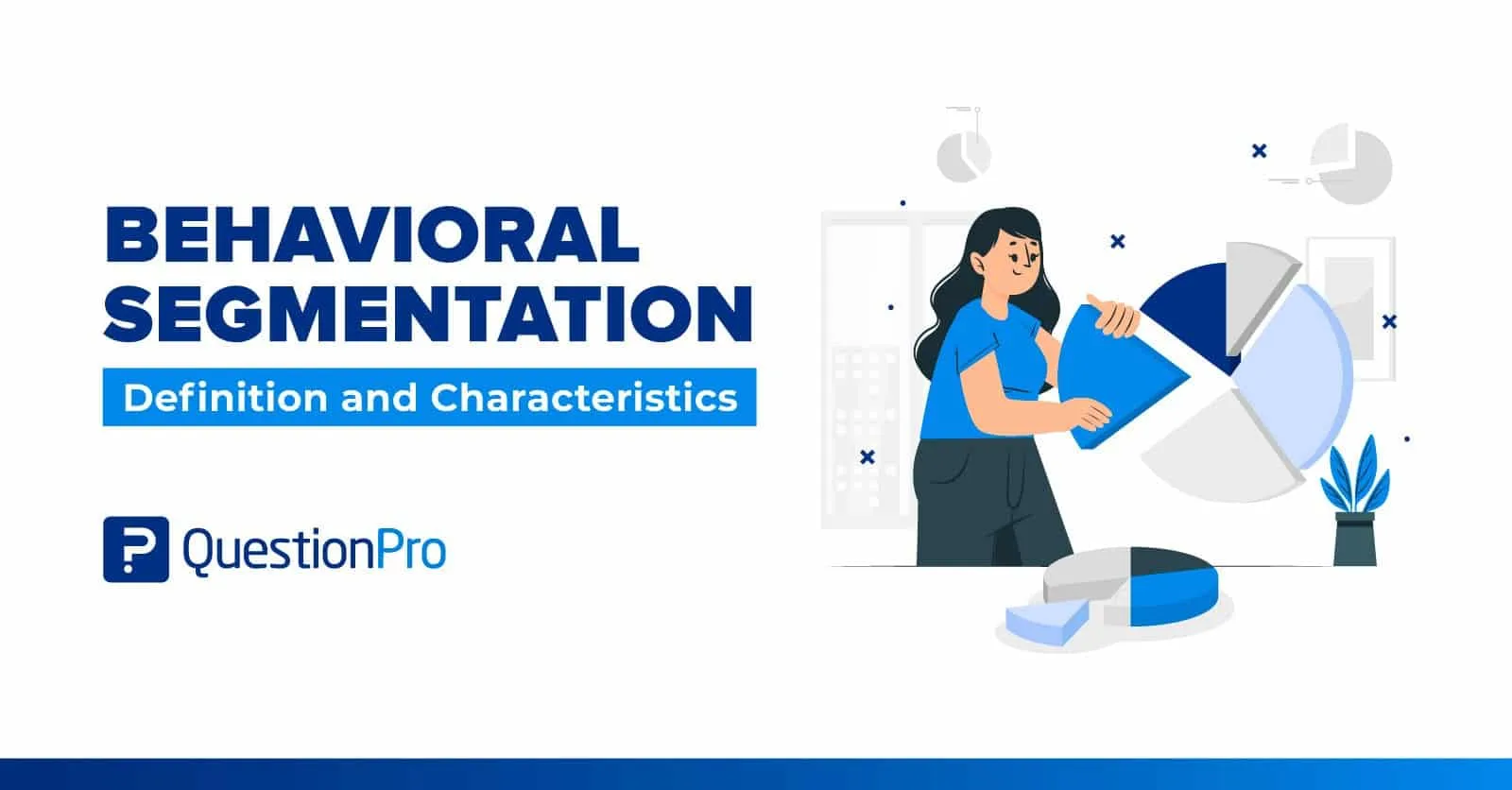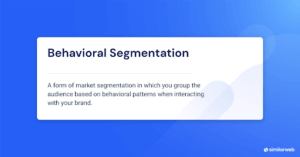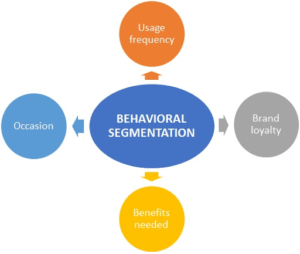
Our views, motives, emotions have a significant impact on who we are, what we do, and how we behave. It’s no surprise that marketers want information on client behavior in order to design efficient marketing efforts.
Market researchers look at things like buyers’ readiness to buy, their level of loyalty, encounters with your brand or product usage experience, and so on.
Through behavioral segmentation, brand marketers enhance their understanding of their clientele, enabling them to offer outstanding material and experiences. What is it, how do you utilize it, and how can it aid in the growth of your brand? The responses you seek can be found within the article below.
Table of Contents
What is Behavioral Segmentation?
Marketing segmentation instrument divides consumers into different groups based on shared behavioral characteristics. Behavioral data assists organizations in understanding how their consumers engage with them.
Within the subject of behavioral marketing, one kind of market segmentation is behavioral segmentation. It investigates commonalities among groups, audiences, prospects, and consumers based on their activities and behaviors. Whereas demographic and psychographic segmentation looks at who your consumers are, behavioral segmentation looks at what they do.
Customers may be classified into various groups based on:
- Their perceptions of your product, business, or service;
- How they use your products or services;
- Customers’ overall knowledge of your organization and its goods;
- Their purchasing patterns, such as just purchasing on special occasions such as birthdays or holidays, etc.
Benefits of Behavioral Segmentation
The following are the primary reasons why it is worth using behavioral segmentation:
-
Aids in identifying your most engaged users
Knowing who your most lucrative customers are and what motivates them may help you improve everything from your operations to your marketing strategy. Your most engaged consumers are those that receive your emails on a regular basis, click on your social media postings, and are the first to express interest in your new items. All of this assists firms in making decisions that immediately affect their budget and resources.
-
Provide customized experiences
When you understand your target market’s requirements, preferences, wants, and expectations, you are more likely to create the correct product or launch the proper marketing campaign. By segmenting your consumers based on their activity patterns, you may decrease abandonment, speed up the purchase process, and lower the bounce rate.
-
It assists you in saving money
You will end up sending the proper campaign to your target market if you use behavioral segmentation. This will lower the cost of your marketing initiatives since you will not have to approach a large number of people and will instead focus on those who are closest to your target market.
-
Aids in pattern prediction
It is possible to anticipate how they will purchase (or act) in the future using behavioral data. Historical customer behavioral patterns may also be used to successfully impact future actions and outcomes.
-
Increases brand loyalty
Customers who are not overwhelmed with unnecessary adverts or messages will feel good about your business since it is unique. They are more likely to engage with the ones that are closer to their preferences if you carefully provide them with material that is closest to their requirements. Customers that receive customized attention are more likely to become brand supporters.
-
Monitors the company’s performance
Businesses may anticipate their health and assess their success against the targets they set for themselves by tracking client behavior patterns and changes in segments over time.
Main Types of Behavioral Segmentation
Businesses may customize their marketing efforts to effectively reach and engage certain target populations by analyzing customer behavior. Here are four examples of common behavioral segmentation:
Purchase behavior
This part focuses on the purchasing patterns of customers, such as frequency, average purchase amount, and product preferences. It assists organizations in identifying loyal consumers, high-value buyers, and those who require nurturing to enhance their purchasing frequency.
Consumption behavior
This segmentation categorizes clients based on their product or service consumption habits. It takes into account aspects including frequency of use, length, and level of involvement. It assists businesses in identifying heavy users, infrequent users, and non-users, allowing them to develop tailored messaging and offers.
Occasion-based behavior
This segmentation examines customer behavior at certain times or events. It takes into account things like seasonal spending trends, holidays, and special events. Businesses may modify their marketing efforts and promotions by knowing how consumers respond at certain times.
Customer loyalty
This segmentation focuses on customer loyalty and assesses the level of commitment and involvement with a brand. It takes into account things like repeat purchases, brand loyalty, and customer retention. Businesses may build loyalty programs, customized incentives, and targeted messages to deepen the connection by recognizing loyal consumers.
To Sum Up
These behavioral segmentation tactics enable firms to gain a better understanding of their clients and customize their marketing efforts accordingly. Businesses may give more relevant messaging, tailored experiences, and offers that engage with their customers by targeting certain behavioral categories, resulting in improved outcomes and customer satisfaction.
RELATED ARTICLES
Latest Articles
 How Long To Soak Chia Seeds: A Simple GuideIn TipsFebruary 11, 2025Chia seeds are little round black seeds that have […]
How Long To Soak Chia Seeds: A Simple GuideIn TipsFebruary 11, 2025Chia seeds are little round black seeds that have […] How to Spot Fake Software Licenses and Avoid ScamsIn TechnologyFebruary 4, 2025Image Credit: pexels.com In today’s complex […]
How to Spot Fake Software Licenses and Avoid ScamsIn TechnologyFebruary 4, 2025Image Credit: pexels.com In today’s complex […] What Factors Should Businesses Consider When Choosing A SIP Trunk Provider?In TechnologyFebruary 1, 2025Under the conditions that are related to running a […]
What Factors Should Businesses Consider When Choosing A SIP Trunk Provider?In TechnologyFebruary 1, 2025Under the conditions that are related to running a […] Best ATV Rentals in Dubai for Unforgettable Desert SafarisIn TravelJanuary 29, 2025Image Credit: pexels.com Dubai is a city that offers […]
Best ATV Rentals in Dubai for Unforgettable Desert SafarisIn TravelJanuary 29, 2025Image Credit: pexels.com Dubai is a city that offers […] The Evolution of Paint Protection Film: Innovations You Need to KnowIn TechnologyJanuary 26, 2025Over the years, Paint Protection Film (PPF) has […]
The Evolution of Paint Protection Film: Innovations You Need to KnowIn TechnologyJanuary 26, 2025Over the years, Paint Protection Film (PPF) has […] Your Ultimate Guide to Local SEOIn MarketingJanuary 17, 2025Local SEO can be defined as optimization of the online […]
Your Ultimate Guide to Local SEOIn MarketingJanuary 17, 2025Local SEO can be defined as optimization of the online […] Top 5 Reasons Why the Organic Traffic Is Really Beneficial for BusinessesIn MarketingJanuary 16, 2025Many companies invest heavily in SEO, with the […]
Top 5 Reasons Why the Organic Traffic Is Really Beneficial for BusinessesIn MarketingJanuary 16, 2025Many companies invest heavily in SEO, with the […] Understanding the Power of Spreadsheet Software for Personal and Business UseIn TechnologyDecember 7, 2024In today’s data-driven world, spreadsheet […]
Understanding the Power of Spreadsheet Software for Personal and Business UseIn TechnologyDecember 7, 2024In today’s data-driven world, spreadsheet […] The Summer Learning Loss – 7 Key Aspects You Must Understand in 2025In TipsNovember 29, 2024Every year, students face summer learning loss during […]
The Summer Learning Loss – 7 Key Aspects You Must Understand in 2025In TipsNovember 29, 2024Every year, students face summer learning loss during […] Equity Trading in Global Markets: Key ConsiderationsIn TipsNovember 4, 2024How prepared are you to explore the possibilities that […]
Equity Trading in Global Markets: Key ConsiderationsIn TipsNovember 4, 2024How prepared are you to explore the possibilities that […] Crafting a Standout Resume and Networking Your Way to Jobs in CanadaIn TipsOctober 23, 2024When applying for jobs in Canada, the format of your […]
Crafting a Standout Resume and Networking Your Way to Jobs in CanadaIn TipsOctober 23, 2024When applying for jobs in Canada, the format of your […] How to invest in the future?In TechnologySeptember 27, 2024Who doesn’t want to build up some extra pension […]
How to invest in the future?In TechnologySeptember 27, 2024Who doesn’t want to build up some extra pension […]
stopie.com is a participant in the Amazon Services LLC Associates Program, an affiliate advertising program designed to provide a means for sites to earn advertising fees by advertising and linking to Amazon.com.
Clicking on an Amazon link from stopie.com does not increase the cost of any item you purchase.
We will only ever link to Amazon products that we think our visitors may be interested in and appreciate learning more about.





